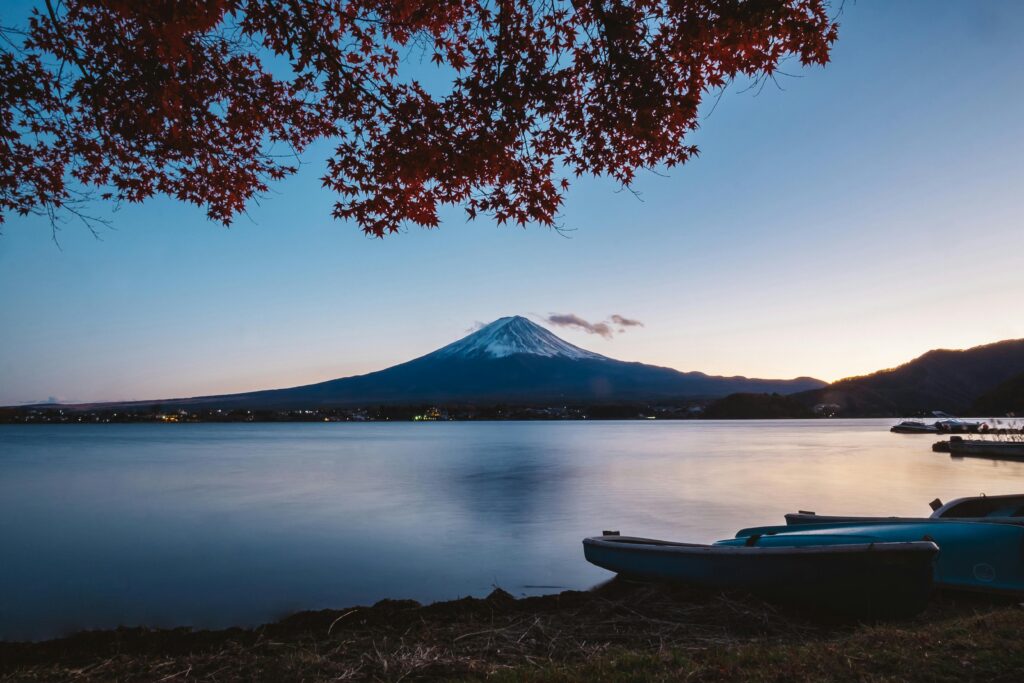Overview
Mount Fuji, or “Fujisan” in Japanese, is Japan’s highest mountain, standing at 3,776 meters (12,389 feet). This iconic stratovolcano is located on Honshu Island, approximately 100 kilometers (62 miles) southwest of Tokyo. Mount Fuji is not only a natural wonder but also a cultural and spiritual symbol of Japan, often depicted in art, literature, and photography.
Geology and Formation
Mount Fuji is a stratovolcano, meaning it is composed of multiple layers of hardened lava, volcanic ash, and other volcanic materials. The mountain’s current shape was formed over thousands of years through several volcanic eruptions. The most recent eruption occurred in 1707, known as the Hoei eruption, which created a secondary crater on the southeast flank of the mountain.
Cultural Significance
Mount Fuji holds immense cultural and spiritual importance in Japan. It has been a sacred site for centuries, revered in Shinto and Buddhist traditions. Pilgrimages to the summit, known as “Fujisan Worship,” have been conducted since ancient times. The mountain is also celebrated in Japanese art and literature, with one of the most famous depictions being Katsushika Hokusai’s woodblock print series “Thirty-Six Views of Mount Fuji.”

Climbing Mount Fuji
Climbing Mount Fuji is a popular activity, attracting hundreds of thousands of climbers each year. The official climbing season is from early July to early September when the weather is relatively mild, and the mountain is free of snow. Outside of this season, climbing is not recommended due to harsh weather conditions and potential hazards.
Climbing Routes
There are four main routes to the summit, each offering unique experiences and varying levels of difficulty:
- Yoshida Trail
- Starting Point: Fuji-Subaru Line 5th Station (2,305 meters/7,562 feet)
- Duration: 5-7 hours ascent, 3-5 hours descent
- Highlights: The most popular route, offering well-maintained trails, numerous mountain huts, and breathtaking sunrise views from the summit.
- Subashiri Trail
- Starting Point: Subashiri 5th Station (1,970 meters/6,463 feet)
- Duration: 6-8 hours ascent, 3-5 hours descent
- Highlights: A less crowded trail that passes through beautiful forests and offers a more tranquil climbing experience.
- Gotemba Trail
- Starting Point: Gotemba New 5th Station (1,440 meters/4,724 feet)
- Duration: 7-10 hours ascent, 3-6 hours descent
- Highlights: The longest and most challenging route, known for its steep inclines and volcanic sand slopes.
- Fujinomiya Trail
- Starting Point: Fujinomiya 5th Station (2,400 meters/7,874 feet)
- Duration: 4-7 hours ascent, 2-4 hours descent
- Highlights: The shortest route to the summit, with fewer crowds and panoramic views of the surrounding landscape.
Climbing Tips
- Acclimatization: To prevent altitude sickness, it is recommended to spend a few hours at the 5th station before ascending further.
- Gear: Proper gear is essential, including sturdy hiking boots, warm clothing, rain gear, and a headlamp for night climbs.
- Mountain Huts: Reservations for overnight stays in mountain huts are advised, especially for those planning to watch the sunrise from the summit.
- Safety: Climbers should be aware of weather conditions, carry sufficient water and food, and follow marked trails to ensure a safe ascent and descent.
Natural Beauty and Scenery
Mount Fuji offers diverse and stunning landscapes, from lush forests at the base to the barren, rocky terrain near the summit. Along the way, climbers are treated to panoramic views of the surrounding lakes, valleys, and other peaks. The sunrise from the summit, known as “Goraiko,” is a particularly magical experience, with the first light illuminating the vast landscape below.
Surrounding Attractions
The area around Mount Fuji is rich in natural beauty and attractions, making it a popular destination for tourists and outdoor enthusiasts:
- Fuji Five Lakes: The lakes—Kawaguchi, Yamanaka, Sai, Shoji, and Motosu—offer opportunities for boating, fishing, and enjoying views of Mount Fuji reflected in the water.
- Aokigahara Forest: Also known as the “Sea of Trees,” this dense forest at the northwest base of the mountain is known for its scenic trails and lava caves.
- Hakone: A nearby resort area famous for its hot springs, museums, and views of Mount Fuji from Lake Ashi.
- Chureito Pagoda: A five-story pagoda with a stunning view of Mount Fuji, particularly beautiful during cherry blossom season.
Environmental Conservation
Mount Fuji and its surrounding areas are protected to preserve their natural beauty and cultural significance. Efforts are made to manage tourism sustainably and mitigate the environmental impact of the large number of visitors. Climbers and tourists are encouraged to follow guidelines, such as carrying out all trash, staying on designated paths, and respecting the natural environment.
Conclusion
Mount Fuji is more than just Japan’s highest peak; it is a symbol of natural beauty, cultural heritage, and spiritual significance. Climbing Mount Fuji is a rewarding experience that offers not only breathtaking views and physical challenge but also a deep connection to Japanese tradition and nature. Whether viewed from a distance, explored through its trails, or experienced through the surrounding attractions, Mount Fuji remains an enduring and iconic destination.